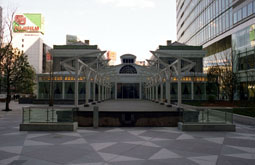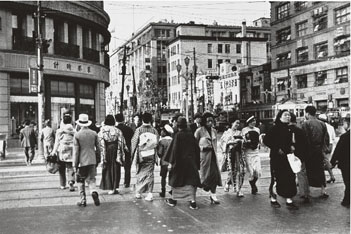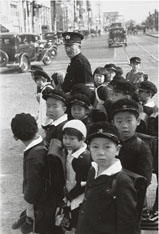 |
|
Here and There introduces art, artists, galleries and museums around Japan that non-Japanese readers and first-time visitors may find of particular interest. The writer claims no art expertise, just a subjective viewpoint acquired over many years' residence in Japan.
|
|
 |
|
|
 |
 |
Prewar Tokyo through the Eyes of a Police Photographer: Koyo Ishikawa at Old Shimbashi Station
Alan Gleason |
 |
 |
|
 |
| The Old Shimbashi Station building, reconstructed in 2003 on the original site, now surrounded by the highrises of Shiodome. Photo courtesy of East Japan Railway Culture Foundation |
|
Rear view of Old Shimbashi Station, showing the first few meters of the platform rebuilt to scale. The original platform extended about 150 meters. Photo courtesy of East Japan Railway Culture Foundation |
Japan's first railway was completed in 1872, just a few years after the fall of Edo Castle and the advent of the Meiji Restoration. The line ran between the port of Yokohama and a terminal in Tokyo named Shimbashi -- there was no Tokyo Station yet. For the next 42 years, Shimbashi was the gateway to the nation's new and rapidly modernizing capital.
Shimbashi Station was built on land formerly occupied by several feudal estates, close by Tokyo Bay. The story goes that, besides availability and easy access to the docks, one factor in choosing the site was its proximity to the new foreigners' settlement in Tsukiji. Placing the train terminal nearby would make it easier to keep tabs on the movement of foreigners in and out of the city, it was reasoned.
The terminal itself was a handsome Western-style building with a stone façade and a 150-meter platform extending out the back. But its heyday was brief: when Tokyo Central Station -- an ornate, domed, red-brick edifice -- opened two kilometers north in 1914, the old terminus was converted into the Shiodome Freight Terminal, and the name Shimbashi was transferred to another station a few blocks to the west on the newly extended Tokaido trunk line. Though the original Shimbashi building burned down in the Kanto Earthquake of 1923, the cargo terminal continued to function until a decline in rail freight transport led to its closure in 1986. No trace was left of the old station building, or so it was thought -- until excavation began for some new highrises on the site in 1991. There, several feet underground, were the original platform stones, nearly intact.
The discovery led to a faithful reconstruction of the old station building exactly where it used to be. Railway and history buffs can find this quaint but beguiling structure hidden amid the Shiodome office complex -- just a stone's throw from the still very bustling "new" Shimbashi Station. Hemmed in on all sides by glassy space-age skyscrapers, Old Shimbashi Station is a curiously anachronistic sight, but a welcome one to this Luddite's eyes. Built directly over the remains of the old station and opened in 2003, the building's Exhibition Hall features a glass floor through which one can peer down onto the original platform foundations. Outside, a truncated replica of the platform juts from the rear of the building, just lengthy enough to give one a sense of how huge the old terminal was.
The Exhibition Hall also displays a hodgepodge of train and travel paraphernalia that was excavated just beneath it in the nineties, including an impressive collection of teapots. (One carries a slogan trumpeting the nation's victory in either the Sino-Japanese or Russo-Japanese War -- archaeologists aren't sure which.)
 |
| Tokyo Central Station around 1935. The massive brick structure was built in 1914 and destroyed during the 1945 air raids. Photo by Koyo Ishikawa, courtesy of Showa-kan |
Upstairs, a larger exhibition space offers through March 21 a fascinating collection of photographs of Tokyo taken during the early Showa Era (1926-89). Though the Shimbashi passenger terminal was by then defunct, the images -- by Koyo Ishikawa (1904-89), a photographer with the Metropolitan Police Department of Tokyo -- are a nice fit for the building, eloquently portraying early 20th-century Tokyo's often surreal juxtapositions of East and West, old and new. Indeed, it appears that well into the mid-thirties, some aspects of Tokyo life had not changed much at all since the Edo of the Shogunate. One evocative shot shows two elaborately coiffed and kimonoed courtesans out for a midday stroll in the Yoshiwara red-light district. It is a scene straight out of an ukiyo-e print -- yet it was taken in 1935.
Co-curated by Tokyo Station Gallery, which is run by the East Japan Railway Culture Foundation, and the government-sponsored National Showa Memorial Museum (Showa-kan), which owns over 9,600 photos by Ishikawa, the exhibition testifies not only to his sharp eye and on-the-job diligence, but also to his playful and sensitive attunement to the lives of fellow Tokyoites. Focusing on his prewar work (Ishikawa's career lasted from 1927 to 1963), the show is about evenly divided among his on-duty productions (including a dramatic, surreptitious shot of the attempted coup of February 26, 1936 in progress), photos of people on trains, buses, streetcars and other modes of transport, and informal street scenes he presumably snapped on his own, between shifts.
English-speaking visitors to Old Shimbashi Station will be gratified by the extensive English signage, which provides full (and well-written) translations of the Japanese explanations. Although the Ishikawa exhibit is resolutely monolingual, the photographs more than adequately speak for themselves, offering an edifying and thoroughly entertaining glimpse of a Tokyo that was still in the throes of transition from feudal castle town to modern metropolis.
 |
|
 |
| The main Ginza intersection, a few blocks north of Shimbashi, 1932: the bustling heart of Tokyo, with shoppers wearing a mix of traditional and Western dress. Photo by Koyo Ishikawa, courtesy of Showa-kan |
|
Office Aida, a legendary and beloved figure in prewar Tokyo, helping schoolchildren cross the busy Sukiyabashi intersection around 1933. Photo by Koyo Ishikawa, courtesy of Showa-kan |
|
|
 |
Koyo Ishikawa -- Documentary Photographs of Showa by a Metropolitan Police Department Cameraman |
 |
7 December 2010 - 21 March 2011 |
 |
Railway History Exhibition Hall, Old Shimbashi Station |
 |
5-3 Shimbashi 1-chome, Minato-ku, Tokyo
Phone: 03-3572-1872
Hours: 11:00-18:00 (admission until 17:45); closed Monday (or Tuesday when Monday is a national holiday), during the New Year holiday, and when changing displays
Transportation: 5-minute walk from the Ginza exit of JR Shimbashi station, or 3-minute walk from Shimbashi subway station (Ginza and Asakusa lines) or Shiodome subway station (Oedo line) |
 |
|
 |
|
|
 |
 |
Alan Gleason
Alan Gleason is a translator, editor and writer based in Tokyo, where he has lived for 25 years. In addition to writing about the Japanese art scene he has edited and translated works on Japanese theater (from kabuki to the avant-garde) and music (both traditional and contemporary). |
|
|
|
 |
|